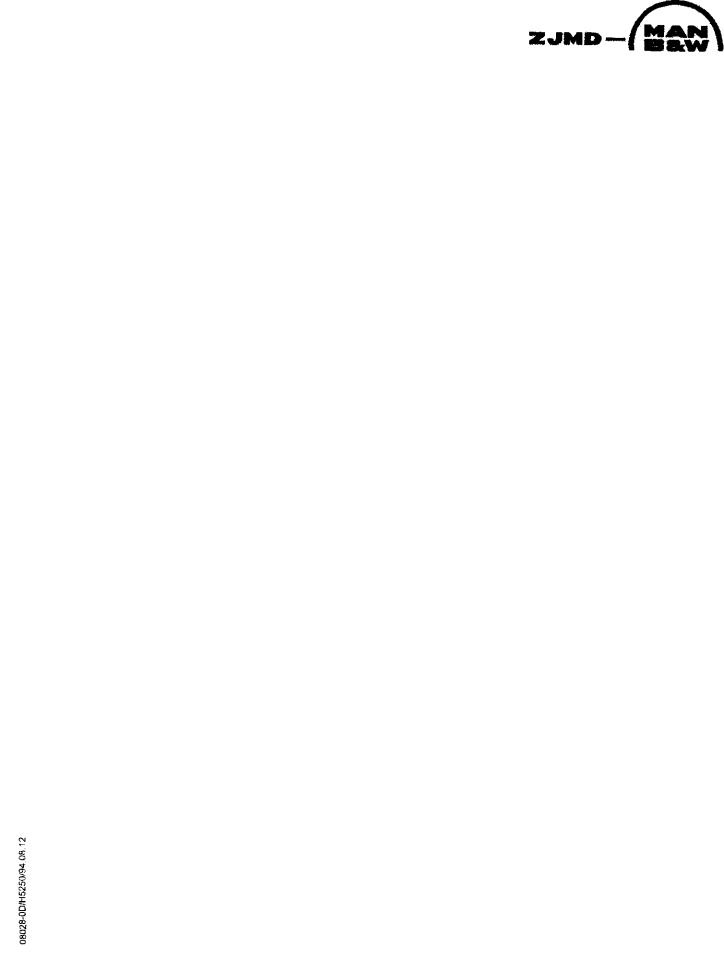
7 семестр (Бормотов А) / 1man_bw_l23_30_chn_23_30_instruktsiya_po_ekspluatatsii_1 / MAN-BW L23-30 H Vol-1 (Instruction)+
.pdf
|
Description |
|
Trouble Shooting Guide for Turbine Starter |
|
503.06 |
||||
|
Page 1 (2) |
|
|
Edition 01H |
|||||
|
|
|
|
|
|
|
|
||
|
|
|
|
|
|
|
|
|
|
|
|
|
|
|
|
|
|
L23/30H |
|
|
|
|
|
|
|
|
|
||
|
|
Trouble |
|
Possible Cause, see working card |
Trouble Shooting |
|
|
||
|
|
|
|
|
|
|
|||
|
|
Motor will not run. |
|
No air supply. |
Check for blockage or damage to air |
|
|||
|
|
|
|
|
|
supply lines or tank. |
|
|
|
|
|
|
|
|
Damaged motor assembly (12). |
Inspect motor assembly and power |
|
||
|
|
|
|
|
|
train and repair power train or |
|
|
|
|
|
|
|
|
|
replace motor assembly, if |
|
|
|
|
|
|
|
|
|
necessary. |
|
|
|
|
|
|
|
|
Foreign material in motor and/or |
Remove motor assembly and piping |
|
||
|
|
|
|
|
piping. |
and remove the blockage. |
|
|
|
|
|
|
|
|
Blocked exhaust system. |
Remove housing exhaust cover (1) |
|
||
|
|
|
|
|
|
and check for blockage. |
|
|
|
|
|
|
|
|
Defective control or relay valve. |
Replace control valve or relay valve. |
|
||
|
|
|
|
|
|
|
|
||
|
|
Loss of power. |
|
Low air pressure to starter. |
Check air supply. |
|
|
||
|
|
|
|
|
Restricted air supply line. |
Check for blockage or damage to air |
|
||
|
|
|
|
|
|
lines. |
|
|
|
|
|
|
|
|
Relay valve malfunctioning. |
Clean or replace lines or relay valve. |
|
||
|
|
|
|
|
|
Lubricate relay valve. |
|
|
|
|
|
|
|
|
Exhaust flow restricted. |
Check for blocked or damaged |
|
|
|
|
|
|
|
|
|
piping. Clean or replace piping. |
|
|
|
|
|
|
|
|
|
Check for dirt or foreign material and |
|
||
|
|
|
|
|
|
clean or remove. Check for ice build- |
|
||
|
|
|
|
|
|
up. Melt ice and reduce moisture |
|
|
|
|
|
|
|
|
|
build-up to starter. |
|
|
|
|
|
|
|
|
Damaged motor assembly. |
Replace motor assembly. |
|
|
|
|
|
|
|
|
|
|
|||
|
|
Drive (57) will not engage. |
No pressure to drive housing port. |
Check air supply. |
|
|
|||
|
|
|
|
|
Internal drive housing ports blocked. |
Remove blockage. |
|
|
|
|
|
|
|
|
Fluid in drive unit components. |
Remove fluid. |
|
|
|
|
|
|
|
|
Damaged or worn piston assembly |
|
|
||
|
|
|
|
|
Replace damaged or worn parts. |
|
|
||
0D/H5250/94.08.12-08028 |
|
|
|
|
(54), O-rings or seals. |
|
|
||
|
|
|
|
Damaged starter drive (57) |
Inspect drive components and |
|
|
||
|
|
|
|
|
O-rings and seals dry. |
Relubricate O-rings and seals. |
|
|
|
|
|
Motor runs, pinion engages, but |
Damaged or broken drive train. |
Disassemble drive train and replace |
|
||||
|
|
does not rotate flywheel. |
|
worn or damaged parts. |
|
|
|||
|
|
Excessive butt engagement. |
Damaged drive pinion (63) or |
Inspect drive pinion and flywheel |
|
|
|||
|
|
|
|
|
flywheel. |
and replace, if necessary. |
|
|
|
|
|
|
|
|
components. |
replace worn or damaged parts. |
|
|
|
|
|
|
|
|
|
Cont. .... |
|
||
|
|
|
|
|
|
|
|
|
|
96.38 - ES0U-G

503.06 |
Trouble Shooting Guide for Turbine Starter |
Description |
Edition 01H |
Page 2 (2) |
|
|
|
|
|
|
|
L23/30H
Trouble |
Possible Cause, see working card |
Trouble Shooting |
|
|
|
|
Low air pressure. |
Check air supply. |
|
Wrong drive pinion. |
Replace with proper drive pinion. |
|
|
|
Oil blowing out of exhaust. |
Oil in air supply line. |
Inspect air line and remove source |
|
|
of oil. |
|
Splash deflector retaining screw (5) |
Install splash deflector retaining |
|
or pipe plug missing. |
screw or pipe plug. |
|
Worn or damaged rotor seals or |
Replace static seals on outside of |
|
static O-rings. |
motor or send motor to Ingersoll |
|
|
Rand to be rebuilt. |
Oil leaking from gear case (28). |
Worn or damaged O-rings. |
Replace O-rings. |
|
Loose joints. |
Make sure that joints fit properly and |
|
|
starter assembly cap screws are |
|
|
tightened to 60 ft-lb (81 Nm) torque. |
|
|
Make sure all seals and O-rings fit |
|
|
and seal properly at their perimeters. |
|
|
If they do not replace with new seals |
|
|
and O-rings. |
|
Excessive high-speed operation. |
Operate according to recommen- |
|
|
dations. |
|
High number of start cycles. |
Replace worn components. |
|
Loose or leaking pipe plugs (10) or |
Tighten or replace pipe plugs using |
|
(11). |
Ingersoll-Rand No SMB-441 pipe |
|
|
sealant. |
|
Splash deflector retaining screw |
Tighten splash deflector retaining |
|
loose or pipe plug missing. |
screw or replace pipe plug. |
Air or gas leakage. |
Loose joints. |
Make sure that joints fit properly and |
|
|
starter assembly cap screws are |
|
|
tightened to 60 ft-lb (81 Nm) torque. |
|
|
Make sure all seals and O-rings fit |
|
|
and seal properly at their perimeters. |
|
|
If they do not, replace with new |
|
|
seals and O-rings. |
|
Excessive high-speed operation. |
Operate according to recommen- |
|
|
dations. |
|
High number of start cycles. |
Replace worn components. |
|
Loose or leaking pipe plugs. |
Tighten or replace pipe plugs. |
|
Splash deflector retaining screw |
Tighten splash deflector retaining |
|
loose or pipe plug missing. |
screw or replace pipe plug. |
|
|
|
08028-0D/H5250/94.08.12
96.38 - ES0U-G

Description |
Trouble Shooting for Cooling Water System |
503.09 |
Page 1 (1) |
Edition 03 |
|
|
|
|
|
|
|
Description
The built-on fresh water pumps in the high and low temperature circuits are of the centrifugal type. They are mounted in the front end box and are driven through the gearing.
General
The pump bearings are lubricated automatically with oil from the lubricating oil system of the engine.
If the pump leaks and the shaft sealing rings are worn, it is recommended to replace the shaft seal, see Working card 516-02.00.
08028-0D/H5250/94.08.12
Trouble |
Possible cause |
Troubleshooting |
|
|
|
Oil or water flows out of the inspec- |
Worn rotating sealing. |
See working card 502-05.00. |
tion holes. |
|
|
|
|
|
The pump does not work after start. |
Pump draws in air at suction side. |
Check packings and pipes for tightness. |
|
The system is not filled-up. |
Check the level in the expansion tank. |
|
Air cannot escape on delivery side. |
Vent the system. |
|
Leaking shaft seal. |
Check the shaft seal. |
|
|
|
Pump capacity drops after normal |
Air leakages from shaft seal. |
Overhaul the shaft seal. |
operation. |
Fouled impeller. |
Clean the impeller. |
|
||
|
|
|
Pump does not give maximum |
Suction valve not fully open. |
Open the suction valve. |
delivery. |
Defective seals. |
Replace the seals. |
|
||
|
Worn impeller and worn wear rings. |
Overhaul the pump. |
|
|
|
Note: Running trouble with the pump, apart from mechanical faults, is most often due to leaks in the suction line. It is therefore essential that all packings and gaskets are in order and that they are renewed when necessary. Even a tiny hole in the suction line will reduce the pump capacity.
98.20 - ES0

Description |
Trouble Shooting for Lubricating Oil Cooler |
503.10 |
Page 1 (2) |
Edition 01 |
|
|
|
|
|
|
|
Trouble Shooting
It is necessary to replace damaged plates or gaskets.
First examine the external conditions around the plate heat exchanger in order to localize the cause of the damage. Do this very carefully.
General
Fatiguefracturewillnormallynecessitatereplacement of all plates and gaskets as there may be a risk of fatigue fracture in all the material.
In case of corrosion, all plates must be examined carefully!
Concerning the work to be carried out see Working card 515-06.00.
|
|
|
Visible Leakage |
|
|
|
|
|
|
|
|
|
|
Trouble |
Possible cause |
Troubleshooting |
|
|
|
|
|
|
|
|
|
Leakage. |
Too high pressure. |
Reduce the pressure to the correct work- |
|
|
|
|
|
ing pressure, see page 500.30 "Operating |
|
|
|
|
|
Data & Set Points". |
|
|
|
|
|
|
|
|
|
Leakage. |
Insufficient tightening. |
Tighten up the plate heat exchanger, but |
|
|
|
(Phase 1) |
|
not below the minimum dimension and |
|
|
|
|
|
never when the plate heat exchanger is |
|
|
|
|
|
under pressure or over 40°C. |
|
|
|
|
|
If the plate heat exchanger is still leaky, |
|
|
|
|
|
proceed to phase 2. |
|
|
|
|
|
|
|
|
|
Leakage. |
Fouled or deformed plates. |
Separate the plate heat exchanger and |
|
|
|
(Phase 2) |
Inelastic or deformed gaskets. |
check if the plates are deformed or fouled. |
|
|
|
|
|
Check that the gaskets are elastic and |
|
|
|
|
|
non-deformed, and that the faces of the |
|
|
|
|
|
joints are clean. |
|
|
|
|
|
Replace deformed plates and gaskets, if |
|
|
|
|
|
any. |
|
|
|
|
|
Before assembling clean all plates and |
|
|
|
|
|
gaskets very carefully. |
|
|
|
|
|
Assemble the plate heat exchanger and |
|
|
|
|
|
start it up again. |
|
|
|
|
|
Note: Even tiny impurities such as sand |
|
|
|
|
|
grains may cause leakage. |
|
|
|
|
|
|
|
|
|
Leakage. |
Gaskets. |
Separate the plate heat exchanger. |
|
|
|
(Even after tightening of the plate heat |
|
Clean the plates very carefully. |
|
0D/H5250/94.08.12 |
exchanger to minimum dimension.) |
|
Replace the gaskets. |
|
|
(Through the drain holes of the gas- |
|
Replace defective plates and gaskets, if |
|
||
|
|
|
|
Assemble the plate heat exchanger and |
|
|
|
|
|
start it up again. |
|
|
|
Leakage. |
Defectivegasketorbadlycorrodedplate. |
Separate the plate heat exchanger. |
|
- |
kets.) |
|
any. |
|
|
08028 |
|
|
Assemble the plate heat exchanger and |
|
|
|
|
|
|
|
|
|
|
|
|
start it up again. |
|
|
|
|
|
|
|
|
|
|
|
|
|
98.20 - ESO

503.10 |
Troubleshooting for Lubricating Oil Cooler |
Description |
Edition 01 |
Page 2 (2) |
|
|
|
|
|
|
|
General
Non-Visible Leakage
Trouble |
Possible cause |
Troubleshooting |
||
|
|
|
|
|
Reduced heat transmission and/or in- |
Fouled plates or choked plate |
Separate the plate heat exchanger and |
||
creasing pressure drop. |
channels. |
check if the plates are fouled. |
||
|
|
|
Clean the plates very carefully. |
|
|
|
|
Assemble the plate heat exchanger and |
|
|
|
|
start it up again. |
|
|
|
|
|
|
Leakage. |
Holes in plates. |
A suspected leakage can be localized in |
||
(The fluids get mixed.) |
Corrosion or fatigue fracture. |
the following way: |
||
(Phase 1) |
|
Remove one of the lower pipe connec- |
||
|
|
|
tions. |
|
|
|
|
Then put the opposite side under pres- |
|
|
|
|
sure. |
|
|
|
|
If the medium continues to run out of the |
|
|
|
|
lower pipe connections after the pressure |
|
|
|
|
has stabilized one or several plates are |
|
|
|
|
leaking. |
|
|
|
|
Close down the plate heat exchanger. |
|
|
|
|
Separate the plate heat exchanger and |
|
|
|
|
check the plates very carefully. |
|
|
|
|
Check suspected plates with a dye pen- |
|
|
|
|
etrant. |
|
|
|
|
Check defective plates and gaskets. |
|
|
|
|
Before assembling, clean all plates and |
|
|
|
|
gaskets. |
|
|
|
|
Assemble the plate heat exchanger and |
|
|
|
|
check to find more defective plates, if any, |
|
|
|
|
by putting one side under press. |
|
|
|
|
Start up again. |
|
|
|
|
|
|
Leakage. |
Holes in plates. |
Close down the plate heat exchanger. |
||
(The fluids get mixed.) |
Corrosion or fatigue fracture. |
Separate the plate heat exchanger. |
||
(Phase 2) |
|
Put all plates to dry. Suspend the plates in |
||
|
|
|
the plate heat exchanger again and tighten |
|
|
|
|
it. |
|
|
|
|
Circulate medium at full capacity on one |
|
|
|
|
plate side (every second plate channel). |
|
|
|
|
Keep the other plate channels unpressu- |
|
|
|
|
rised and free from liquid! |
|
|
|
|
Stop the circulation after a few minutes of |
|
|
|
|
operation and open the plate heat ex- |
|
|
|
|
changer again. Take care to avoid water |
|
|
|
|
spraying onto the dry plate side! |
|
|
|
|
By a careful study of the plates it will be |
|
|
|
|
possible to find moist areas, if any, on the |
|
|
|
|
otherwise dry plate sides. |
|
|
|
|
Check these areas with a dye penetrant! |
|
|
|
|
Replace defective plates and gaskets. |
|
|
|
|
Before assembling, clean all plates and |
|
|
|
|
gaskets. |
|
|
|
|
Assemble the plate heat exchanger and |
|
|
|
|
check to find more defective plates, if any, |
|
|
|
|
by putting one side under press. |
|
|
|
|
Start up again. |
|
|
|
|
If the unit is still leaking, check all plates |
|
|
|
|
with a dye penetrant! |
|
|
|
|
|
|
08028-0D/H5250/94.08.12
98.20 - ES0

Index |
|
Specification and Treatment |
|
504 |
Page 1(1) |
|
Lubricating Oil, Fuel Oil and Cooling Water |
|
|
|
|
|
||
|
|
|
|
|
|
|
|
|
L23/30H |
Description |
|
|
||
|
Lubricating Oil Specification.................................................................................................. |
504.01.(07H) |
||
|
Maintenance of Lubricating Oil Condition............................................................................ |
504.03.(04H) |
||
Criteria for Cleaning/Exchange of Lubricating Oil............................................................. |
504.04.(05H) |
|||
|
Lubricating Points.................................................................................................................... |
504.05.(01H) |
||
Lubricating Oil in Base Frame............................................................................................. |
504.06.(01H) |
|||
|
Lubricating Oil in Base Frame................................................................................................. |
504.06.(01H) |
||
Specific Lubricating Oil Consumption SLOC ............................................................... |
504.07.(01H) |
|||
|
Fuel Oil Specification.............................................................................................................. |
504.20(.04H) |
||
|
Fuel Oil Quality............................................................................................................................ |
504.25.(04H) |
||
|
Nomogram for Determination of CCAI.......................................................................... |
504.26.(02H) |
||
|
Analysis Data................................................................................................................................. |
504.27.(02H) |
||
|
Fuel Oil Cleaning.................................................................................................................... |
504.30.(01H) |
||
|
Fresh Water System Treatment........................................................................................ |
504.40.(02H) |
||
Working Card
Plates

Description |
Lubricating Oil Specification |
504.01 |
Page 1 (1) |
Edition 07 |
|
|
|
|
|
|
|
08028-0D/H5250/94.08.12
Requirement
This document is valid for the following engine types: L16/24, L21/31, L23/30H, L27/38, L28/32H, V28/ 32H, V28/32S and L32/40.
Heavy Duty lubricating oil (HD-Lube oil) has to be used coresponding to at least type CF after API service system (http://api-ep.api.org/filelibrary/ ACF1E1.pdf). Further the oil should be rust and oxidation inhibited.
Viscosity
Marine
Engine SAE class L23/30H, L+V28/32H
30* 105 mm2/sec at 40° C
L16/24, L21/31, L27/38, L32/40
40 145 mm2/sec at 40° C
Stationary
L16/24, L21/31, L27/38, L23/30H,
L+V28/32H, V28/32S
40145 mm2/sec at 40° C
*At cooling water temperatures above 32° C SAE 40 oil can be used. In this case, please contact MAN B&W, Holeby.
Guiding Values for TBN
When selecting lubricating oil, attention must be paid to the fuel oil sulphur content.
Marine GenSet engines are normally running at low load compared to propulsion engines, therefore the absolute fuel consumption is lower and consequently the lube oil is exposed to a smaller amount of sulphur. Therefore the TBN-value (Total Base Number) of the lube oil has to be lower to neutralise the sulphur from the fuel.
The consumption of lube oil has influence on recommended initial TBN value. When the lube oil consumption is high, low TBN values is recommended, and opposite. How to evaluate the lube oil consumption, please see section B 12 15 0 "Specific Lubricating Oil Consumption".
General
Based on typical load profile for marine GenSet (5060% of rated power) and for stationary GenSet (50100% of rated power)
For all engines except L32/40
Oil type |
TBN |
TBN |
|
(Initial) |
(Equilibrium) |
|
|
|
Gas oil |
8-12 |
6-8 |
Marine diesel |
10-15 |
8-10 |
Heavy fuel oil (S<1.5%) |
15-20 |
8-10 |
Heavy fuel oil (S>1.5%) |
20-40 |
10-18 |
|
|
|
For engines L32/40
Oil type |
TBN |
TBN |
|
(Initial) |
(Equilibrium) |
|
|
|
Gas oil |
12-15 |
6-8 |
Marine diesel |
15-25 |
8-10 |
Heavy fuel oil (S<1.5%) |
25-35 |
8-10 |
Heavy fuel oil (S>1.5%) |
30-40 |
10-18 |
|
|
|
For low loaded marine GenSet engines are recommended the lowest TBN values and for high loaded stationary engines are recommended the highest TBN values. If load profile is different, this should be taken in consideration. However, the operation results are the criteria that prove which TBN is the most economical one for efficient engine operation.
04.20 - ES1

Description |
Maintenance of Lubricating Oil Condition |
504.03 |
Page 1 (2) |
Edition 04 |
|
|
|
|
|
|
|
08028-0D/H5250/94.08.12
General
During operation of trunk engines the lubricating oil will be contaminated slowly by small particles originating from the combustion.
The burning of heavy fuels will normally increase this contamination due to the increased content of carbon residues and other impurities.
Contamination of lubricating oil with water, fresh or salt, can also take place.
A certain amount of contaminants can be kept suspended in the lubricating oil without affecting the lubricating properties.
But the condition of the lubricating oil should be kept under observation by analyzing oil samples. See also 504.04 "Criteria for Cleaning/Exchange of Lubricating Oil".
The engine bearings are protected by the full-flow lubricating oil filter built onto the engine, the filter cartridges having a fineness of 15 micron and the safety filter a fineness of 60 micron.
The condition of the lubricating oil can be maintained/reestablished by exchanging the oil at fixed intervals or based on analysis results.
Operation on Marine Diesel Oil (MDO)
The built-on full-flow dept filter cleans the oil thoroughly. For operation on MDO we recommend to install a built-on centrifugal by-pass filter too.
Operation on Heavy Fuel Oil (HFO)
For engines operating on HFO a lub. oil centrifugal unit is required.
Continuous lub. oil centrifugation plus a built-on fullflow depth filter clean the oil in a sufficient and safe way. Any other filter system is not necessary, but not wasted.
General
A more economical solution is to maintain the condition by continuous treatment. Experience has proved that centrifuging is superior to other methods of cleaning lubricating oils.
The optimum cleaning effect is achieved by keeping the lubricating oil in a state of low viscosity for a long period in the centrifuge bowl.
Low viscosity is obtained by preheating the lubricating oil to a temperature of 85°C - 95°C.
Slow passage of the lubricating oil through the centrifugal separator is obtained by using a reduced flow rate and by operating the separator 24 hours a day, stopping only when cleaning of the bowl is necessary.
When treating detergent type lubricating oil, the flow rate is usually recommended to be reduced to 1525% of the rated flow of the separator.
In order to keep the amount of lubricating oil in the engine in good condition, it is necessary to treat 0.3- 0.4 l/kw per hour.
A centrifuge for treating this amount of lubricating oil under the aforementioned derated flow conditions should have a rated capacity of 1.5-2.5 l/kw per hour, but in each case the separator manufacturer's recommendations for capacity and operating instructions should be followed.
For engines with cartridge-type oil filters (depth filters), continuous and efficient purification of the oil in the separator is essential to ensure a long service life for the cartridge filters.
For cleaning of the lubricating oil system after overhauls and inspection of the lubricating oil piping system, see section 515.
Deterioration of Oil
Oil seldom loses its ability to lubricate, i.e. to form a friction-decreasing oil film, but it may become corrosive to the steel journals of the bearings in such a way that the surface of these journals becomes too rough and wipes the bearing surface.
02.16 - ES0 - G

504.03 |
Maintenance of Lubricating Oil Condition |
Description |
|
Edition 04 |
Page 2 (2) |
||
|
|||
|
|
||
|
|
|
General
In that case not only must the bearings be renewed, but the journals must also be polished. The corrosiveness of the lubricating oil is either due to far advanced oxidation of the oil itself (TAN) or to the presence of inorganic acids (SAN). In both cases the presence of water will multiply the effect, especially an influx of sea water as the chloride ions act as an inorganic acid.
Oxidation of Oils
At normal service temperature the rate of oxidation is insignificant, but the following factors will accelerate the process:
High Temperature
If the coolers are ineffective the temperature level will generally rise.
Ahightemperaturewillalsoariseinelectricalpreheaters if circulation is not continued for 5 minutes after the heating has been stopped, or if the heater is only partly filled with oil.
Catalytic Action
Oxidation of the oil will be accelerated considerably if catalytic particles are present in the oil. Wear particles of copper are especially harmful, but also ferrous particles and rust are active. Furthermore, the lacquer and varnish-like oxidation products of the oil itself have an accelerating effect. Continuous cleaning of the oil is therefore important to keep the sludge content low.
Signs of Deterioration
If circulating oil of inferior quality is used and the oxidative influence becomes grave, prompt action is necessary as the last stages in the deterioration may develop surprisingly quickly, i.e. within one or two weeks. Even if this seldom happens, it is wise to be acquainted with the signs of deterioration.
These may be some or all of the following:
-Sludge precipitation in purifier multiplies.
-Smell of oil becomes acrid or pungent.
-Machined surfaces in crankcase become coffee brown with a thin layer of lacquer.
-Paint in crankcase peels off or blisters.
-Excessive carbon is formed in the piston cooling chamber.
In a grave case of oil deterioration, the system should be cleaned thoroughly and refilled with new oil.
Water Washing
Water washing of HD oils must not be carried out.
Water in the Oil
If the TAN is low, a minor increase in the fresh water content of the oil is not immediately detrimental while the engine is running. Naturally, it should be brought down again as quickly as possible (below 0.2% water content, which is permissible). If the engine is stopped while corrosion conditions are unsatisfactory it should be turned just over 1/2 revolution once every hour (i.e. stop in different positions) while the oil circulation and purifying at a high preheating temperature continue to remove water. Water in the oil may be noted by steam formation on the sight glasses, by appearance, or ascertained by immersing a piece of glass or a soldering iron heated to 200300°C in an oil sample. If there is a hissing sound, water is present. If a large quantity of water has entered the oil system, it may be profitable to suck up sedimented water from the bottom of the tank. Taste the water for salt. If salty, an oil sample should be analysed immediately for chloride ions.
08028-0D/H5250/94.08.12
02.16 - ES0 - G

Description |
Criteria for Cleaning/Exchange of Lubricating Oil |
504.04 |
Page 1 (2) |
Edition 05 |
|
|
|
|
|
|
|
08028-0D/H5250/94.08.12
Replacement of Lubricating Oil
The expected lubricating oil lifetime in operation is difficult to determine. The lubricating oil lifetime is depending on the fuel oil quality, the lubricating oil quality,thelubricatingoilconsumption,thelubricating oil cleaning equipment efficiency and the engine operational conditions.
In order to evaluate the lubricating oil condition a sample should be drawn on regular basis at least once every three month or depending on the latest analysis result. The lubricating oil sample must be drawn before the filter at engine in operation. The sample bottle must be clean and dry, supplied with sufficient indentification and should be closed immediately after filling. The lube oil sample must be examined in an approved laboratory or in the lubricating oil suppliers own laboratory.
A lubricating oil replacement or an extensive lubricating oil cleaning is required when the MAN B&W exchange criteria's have been reached.
Evaluation of the Lubricating Oil Condition
Based on the analysis results, the following guidance are normally sufficient for evaluating the lubricating oil condition.
1.Viscosity
Attention limit: < ±one viscosity grade
Units |
: mm2/s (cSt) |
Possible test |
|
methods |
: ASTM D-445, DIN 51562/53018 |
Increasing viscosity indicates problems with insolubles,HFOcontamination,watercontamination, oxidation, nitration and low load operation. Decreasing viscosity is generally due to dilution with lighter viscosity oil.
General
2. Flash Point
Limit value |
: > 185° C |
Possible test |
|
method |
: ASTM D-92 |
Normally used to indicate fuel dilution.
3. Water Content
Attention limit: < 0.1
Unit |
: Weight % |
Possible test |
|
method |
: ASTM D4928 |
Water can originate from contaminated oil, an engine coolingwaterleakorformedaspartofthecombustion process. If water is detected also Sodium, Glycol or Boron content should be checked in order to confirm engine coolant leaks.
4. Total Base Number (TBN)
Unit |
: mg KOH/g |
|
|
|||
Possible test |
|
|
|
|
|
|
method |
: ASTM D-2896 |
|
|
|||
Attention limit: |
|
|
|
|
||
|
Fuel oil type |
|
TBN |
|
TBN (equi- |
|
|
|
|
||||
|
|
|
|
(initial) |
|
librium) |
|
|
|
|
|
|
|
|
Gas oil, MGO |
|
8-12 |
|
6-8 |
|
|
Marine diesel, MDO |
|
10-15 |
|
8-10 |
|
|
Heavy fuel, HFO |
|
15-20 |
|
|
|
|
Sulphur < 1.5% |
|
|
8-10 |
||
|
Sulphur > 1.5% |
|
20-40 |
|
10-18 |
|
|
|
|
|
|
|
|
The neutralization capacity must secure that the acidic combustion products, mainly sulphur originate from the fuel oil, are neutralized at the lube oil consumption level for the specific engine type. Gradually the TBN will be reduced, but should reach an equilibrium.
04.20 - ES1
